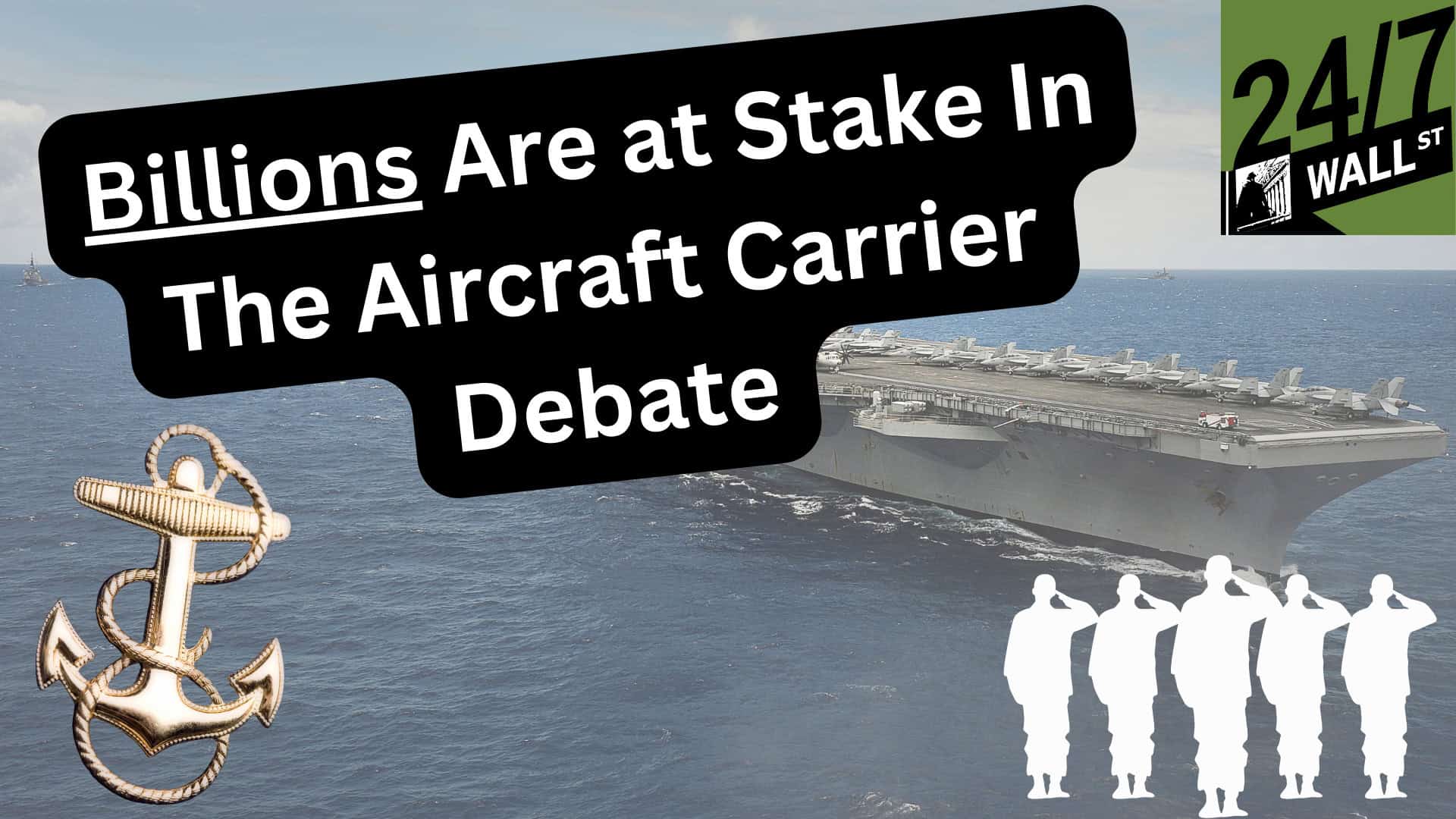
Michael Muir discusses the relevance of aircraft carriers in modern warfare, emphasizing their deterrence value and strategic flexibility despite advancements in missile and drone technology. He compares the current debate to historical shifts in military strategy, such as the transition from battleships to aircraft carriers during World War II, and highlights the carriers’ mobility and symbolic power.
Transcript:
Okay, so I’m joined by Michael Muir, one of our analysts on 247wallstreet.com.
And Michael, I want to talk about some of your recent pieces and in particular with sort of the changing order and the changing dynamics and conflicts that we’re seeing all across the world.
I’ve seen a lot of people make the argument that sort of the large scale, big ship, big plane kind of kinetic warfare of yesteryear might be dated.
And I’m curious to get your opinion.
If I look at something like aircraft carriers, I mean, arguably the largest, most impressive defensive vehicle on earth today, are they still relevant in the new world order that we’re seeing with missiles and drones and autonomy here in AI area?
Talk to me about the role that aircraft carriers play today.
Sure.
I mean, it’s a fascinating debate because there are some very clear historical parallels we can draw upon.
In fact, the aircraft carrier itself was the result of a major paradigm shift that took place during World War II.
So conventional thinking was the battleship was the centerpiece of a fleet.
And we found that in the Pacific theater that the aircraft carriers significantly outperformed battleships to the point where they were basically obsolete.
And Japan found that to their cost where they had Yamato and Musashi, which were the greatest examples of battleships ever built.
But the second they took to the seas, they were essentially obsolete.
So what people are arguing today is that we’re seeing another paradigm shift where the aircraft carrier is essentially the battleship of the 20th century is the aircraft carrier in the 21st century.
Does the enormous cost of these ships now viable?
So we’re really going to have to do a lot of things here when we talk about if aircraft carriers are still relevant to defense.
One of the first things we do have to ask ourselves is what are the objectives?
Which may sound a little strange, but is it battle efficiency or deterrence?
These are essentially two different things.
And when we talk about the battleship, if it’s still relevant, now maybe we could make the argument that a ballistic submarine or autonomous drones can have similar performance on the battlefields or in the seas.
But do they have the same deterrence as an aircraft carrier?
Which is one of the reasons why I think they’re still relevant to some extent.
So I love this point that you make.
So it’s really interesting.
We might be able to look at the technical capabilities of something like an aircraft carrier.
And a lot of people maybe imagine the height of war.
Are they as effective when you have something like nuclear submarines and missiles and drones?
But there’s this whole other utility that aircraft carriers provide, which is deterrence and defense.
You can project power across the world.
And you made the point in your piece that with 5,000 American lives on one of these ships, it is a major escalation to attack one.
Exactly.
And therefore putting these ships in certain regions around the world that look like they might be escalating tensions actually can serve to reduce tensions because nobody is willing to take that extra step of attacking them.
So there’s this whole other realm of utility beyond just pure kinetic warfare.
And we can actually, sorry to interrupt, we can actually point out a very specific example which is relevant to our conversation today is if we go back to 1996 and the Taiwan Strait crisis was essentially solved by putting aircraft carriers through the Taiwan Strait as a very strong show of force and deterrence.
So I think they still have a very big role to play in defense.
And then as you touch upon there, having the capacity to sink an aircraft carrier is one thing, but actually doing it is something else entirely.
And that’s not to say that would be an easy thing to achieve anyway.
The last time the United States lost an aircraft carrier in combat was World War Two.
They have not even come close to losing one in the last 70 years.
And just because China has, because obviously China is going to be the adversary that’s most likely to pose a threat to United States aircraft carriers, just because they have the capacity to do so.
One, it’s unproven.
China hasn’t been at war actively since 1979.
And two, the difference between an aircraft carrier and let’s just say an air base is that aircraft carriers can move.
You know, the A2AD, that’s anti-access area denial munitions, which China has substantially invested in the last 25 years, they can reach Guam, they can reach air bases in South Korea, Japan, but aircraft carriers aren’t just going to sit still and wait for the barrage.
Now, we don’t think of mobility when we think of an aircraft carrier, but they can cover about 700 miles in a single day.
So by one estimate, it would take about 25 minutes to locate, track, and target an aircraft carrier, by which time it can move 10, 15 miles away.
So the tactical or strategic flexibility of an aircraft carrier is still significant.
Wonderful.
All right, well, there you have it.
So it sounds like, you know, the role that aircraft carriers play today is multifaceted, multidimensional.
We’re not purely talking about combat.
There’s deterrence, there’s shows of force.
And then there’s also the point that you raised, which I really appreciate, which is, you know, if someone were to attack and sink an aircraft carrier, it is not as easy as it seems to be an enormous escalation.
So by the time that actually happens, we are probably deep, deep into conflict at which point aircraft carriers still have this whole other realm of relevance and being able to deliver aircraft and missiles and defense to other regions of the world.
Yeah, absolutely.
There’s another historical aspect I’d like to just draw your attention to.
There’s a big difference between a new weapon being available and being effective.
The obvious historical example I would point to would be the tank.
Battlefield’s debut took place in 1916 during the Battle of the Somme.
The tanks were used during World War I, but not terribly effectively because they had significant mechanical problems.
A weapon system cannot become effective until it has been properly tested.
So it wasn’t really until 1940 that we saw tanks being used effectively on a strategic level.
So that, I think, is the same argument we can make about autonomous weapon systems and anti-ship munitions as they haven’t been proven in combat between two forces of relatively equal strength.
One point we might want to make here as well is that, you know, we’re seeing the very poor performance of the Russian fleet in the Black Sea, but they’re confined, and they’re very vulnerable to kamikaze drones and anti-ship munitions.
But that is not going to play out necessarily in, let’s say, a Pacific war scenario where there’s a lot more room to maneuver.
So I think that’s another point I would just like to add right at the end of our discussion is that just because you can, it doesn’t mean it’s going to work right off the bat.
It usually takes time.
Is Your Money Earning the Best Possible Rate? (Sponsor)
Let’s face it: If your money is just sitting in a checking account, you’re losing value every single day. With most checking accounts offering little to no interest, the cash you worked so hard to save is gradually being eroded by inflation.
However, by moving that money into a high-yield savings account, you can put your cash to work, growing steadily with little to no effort on your part. In just a few clicks, you can set up a high-yield savings account and start earning interest immediately.
There are plenty of reputable banks and online platforms that offer competitive rates, and many of them come with zero fees and no minimum balance requirements. Click here to see if you’re earning the best possible rate on your money!
Thank you for reading! Have some feedback for us?
Contact the 24/7 Wall St. editorial team.



